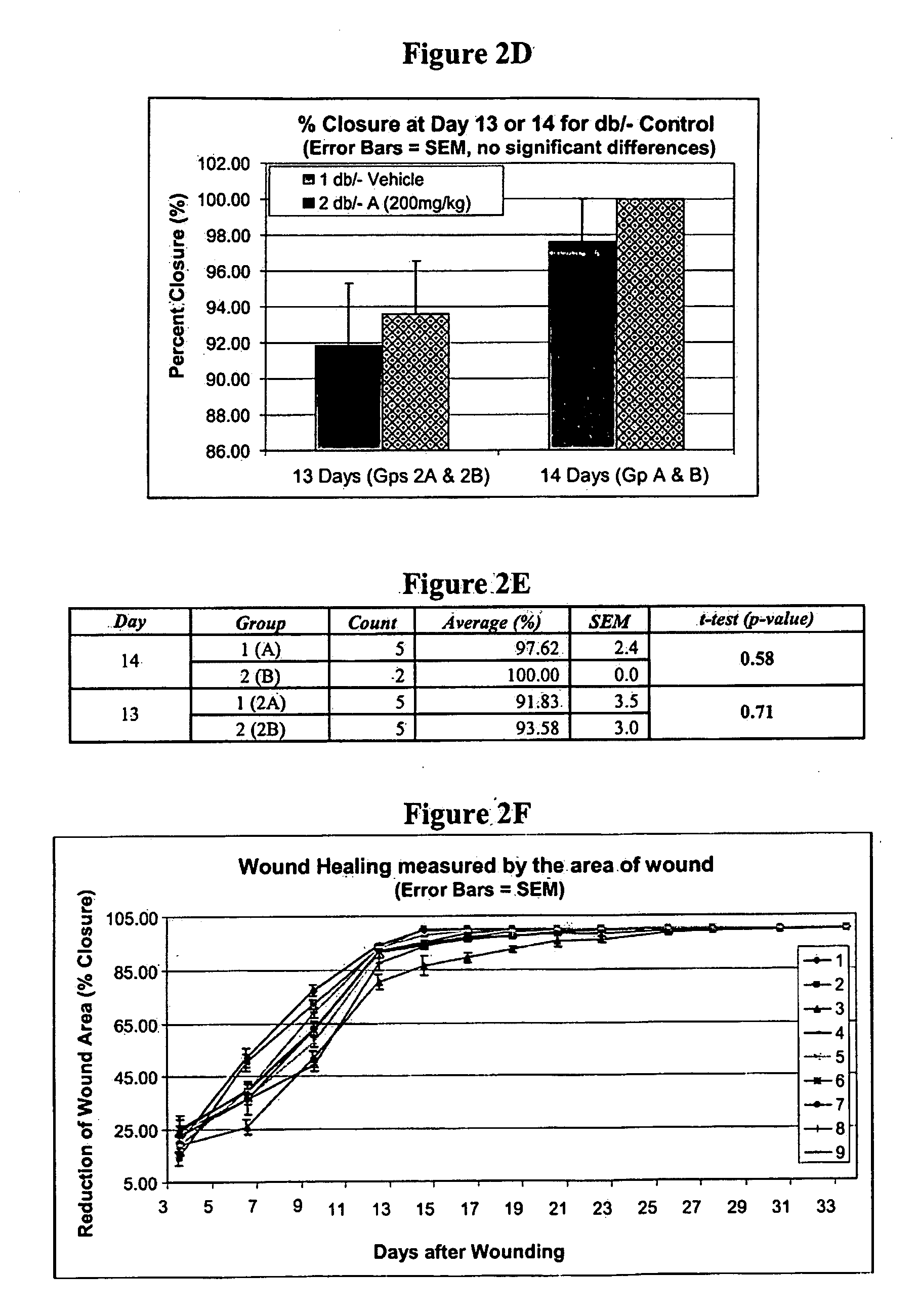Treatment of diabetic wounds and peripheral neuropathies
a technology for applied in the field of diabetic wounds and peripheral neuropathies, can solve the problems of poor wound healing, impaired circulation, poor wound healing in diabetic patients, etc., and achieve the effects of reducing symptoms, reducing complications, and reducing pain
- Summary
- Abstract
- Description
- Claims
- Application Information
AI Technical Summary
Benefits of technology
Problems solved by technology
Method used
Image
Examples
example 1
[0200]Diabetic mice homozygous for the db gene develop insulin-resistant diabetes and obesity due to a defect in the central leptin satiety receptors, essentially eating themselves into diabetes. The db / db mice have previously been shown to undergo delayed wound healing in comparison to non-diabetics.
[0201]The BKS.Cg-m+ / + Leprdb / J homozygous mouse carries the spontaneous diabetes mutation (Leprdb) and become identifiably obese around 3 to 4 weeks of age. Elevations of plasma insulin begin at 10 to 14 days and of blood sugar at 4 to 8 weeks. Homozygous mutant mice are polyphagic, polydipsic, and polyuric. On the C57BLKS background, these mice exhibit an uncontrolled rise in blood sugar, severe depletion of the insulin-producing beta-cells of the pancreatic islets, and death by 10 months of age. Peripheral neuropathy and myocardial disease are evident, metabolic efficiency is increased, and wound healing is delayed. The BKS.Cg-m+ / + Leprdb / J mouse represents a well characterized model ...
example 2
[0225]Homozygous, diabetic mice described above, and wounded in the manner described above in Example 1, were treated by topical administration of iroxanadine or arimoclomol. A 4% w / v aqueous solution of arimoclomol were separately administered topically to the wounded position. Oral dosage of iroxanadine was at 10 mg / kg IP, b.i.d., a relatively low concentration.
[0226]When analyzed by 2-way ANOVA, systemic administration of iroxanadine via oral dosage, after a short delay, tended to show an accelerated healing in the middle stage of healing (FIG. 6). Treatment with arimoclomol clearly showed an accelerated healing of wounds that received topical administration of arimoclomol (FIG. 7).
[0227]Thus, there is a statistically significant acceleration of the wound healing process in a subject afflicted with diabetes when a hydroxylamine compound or composition described herein is administered.
[0228]Every patent and non-patent publication that is included herein is incorporated herein by r...
example 3
[0230]Rat STZ-induced diabetic neuropathy has been described as sharing similar features with human diabetic neuropathy. See Wei et al., Heart Lung Circ., 12:44-50 (2003). Similar to diabetic patients, STZ-rats develop an acute decrease in nerve blood flow and slowing of nerve conduction velocity followed by axonal atrophy of nerve fibers. Nerve fiber degeneration processed as assessed by loss of IENF in skin biopsies of STZ-rats was also demonstrated.
[0231]Fifty male Wistar rats were housed and maintained in a room with controlled temperature and a reverse light-dark cycle. Diabetes was induced in forty animals by injection of a buffered solution of STZ (55 mg / kg) in 0.1 mol / citrate buffer pH 4.5. The control group (10 animals) was given an equal does of buffer. The day that STZ was injected was considered day 0. One week later (day 7), blood glucose levels were monitored and rats with glycemia (>260 mg / dl) were deemed diabetic.
[0232]The STZ-diabetic rats were divided into four gro...
PUM
| Property | Measurement | Unit |
|---|---|---|
| Fraction | aaaaa | aaaaa |
| Fraction | aaaaa | aaaaa |
| Fraction | aaaaa | aaaaa |
Abstract
Description
Claims
Application Information
 Login to View More
Login to View More - R&D
- Intellectual Property
- Life Sciences
- Materials
- Tech Scout
- Unparalleled Data Quality
- Higher Quality Content
- 60% Fewer Hallucinations
Browse by: Latest US Patents, China's latest patents, Technical Efficacy Thesaurus, Application Domain, Technology Topic, Popular Technical Reports.
© 2025 PatSnap. All rights reserved.Legal|Privacy policy|Modern Slavery Act Transparency Statement|Sitemap|About US| Contact US: help@patsnap.com



